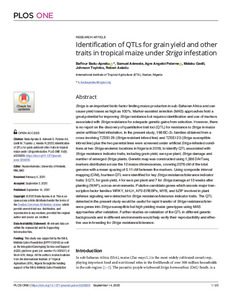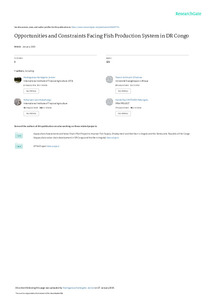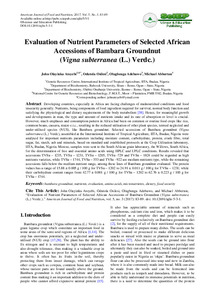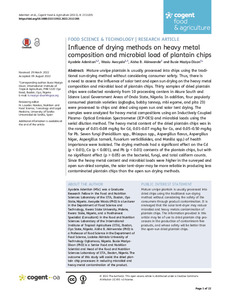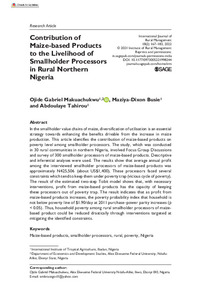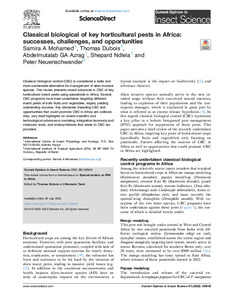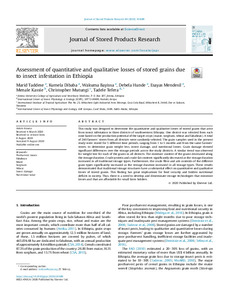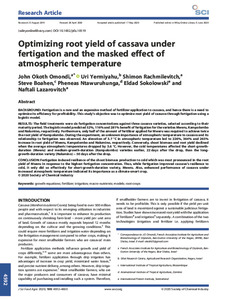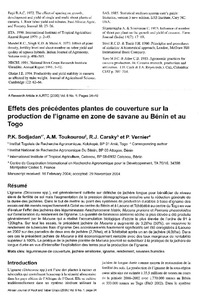Welcome to the International Institute of Tropical Agriculture Research Repository
Journal and Journal Articles: Recent submissions
Now showing items 501-520 of 5157
-
Bio-protective effect of a root-nodulating Rhizobium etli strain in common bean (Phaseolus vulgaris) against Meloidogyne incognita and Radopholus similis in an in vitro autotrophic tripartite culture system
(2020)The bio-protective effect of a root-nodulating strain (CNPAF 512) of the nitrogen-fixing rhizobium, Rhizobium etli, against both a sedentary (Meloidogyne incognita) and a migratory (Radopholus similis) endoparasitic nematode in common bean (Phaseolus vulgaris) was examined using an in vitro autotrophic tripartite culture system. Two in vitro assays were carried out with each of the nematode species. Each assay consisted of two treatments: the plants were either inoculated with the rhizobial strain ... -
Identification of QTLs for grain yield and other traits in tropical maize under Striga infestation
(2020)Striga is an important biotic factor limiting maize production in sub-Saharan Africa and can cause yield losses as high as 100%. Marker-assisted selection (MAS) approaches hold a great potential for improving Striga resistance but requires identification and use of markers associated with Striga resistance for adequate genetic gains from selection. However, there is no report on the discovery of quantitative trait loci (QTL) for resistance to Striga in maize under artificial field infestation. In ... -
Opportunities and constraints facing fish production system in DR Congo
(2019-12)The current aquaculture production systems in the village environment and their constraints and opportunities were studied to understand the reasons for the decrease in the number of fishponds in South Kivu, eastern DR Congo. . Little is known about fish production in South Kivu; thus, this study was carried out in two phases: a survey, a follow-up of the farms over the course of a year and a literature review. Accordingly, 305 aquaculturists from three territories were interviewed from May to ... -
Quantification of selected anti - nutrients and bioactive compounds in African Bambara Groundnut (Vigna subterranea (L.) verdc.)
(2018)Bioactive compounds in plants, being secondary metabolites are important phyto-chemicals, that form the basis of modern pharmacology and medical treatment because it has natural beneficial compounds such as in nutraceuticals, micronutrients e.t.c. Neglected legumes like Bambara groundnut (Vigna subterranea (L.) Verdc.) can serve as a high nutrient pulse and also as food supplements. However, despite the fact that Bambara groundnut contains these beneficial bioactive compounds, it also has some ... -
Morphological characterisation of selected African accessions of bambara groundnut (Vigna subterranea (L.) verdc.)
(2017)Three hundred (300) accessions of Bambara groundnut (Vigna subterranea (L.) Verdc) among the 1973 maintained in the global repository at the International Institute of Tropical Agriculture (IITA), Ibadan, genebank were selected for this study. Two to three seeds of each accession were planted during the 2014 / 2015 planting season at IITA, Ibadan, Nigeria. Seedlings were thinned to a single plant prior to flowering. Thirty - seven (37) agro-morphological parameters, representing 28 quantitative ... -
Evaluation of nutrient parameters of selected African accessions of Bambara groundnut (Vigna subterranea (L.) verdc.)
(2017)Developing countries, especially in Africa are facing challenges of malnourished conditions and food insecurity generally. Nutrients, being components of food ingredient required for survival, normal body function and satisfying the physiological and dietary requirements of the body metabolism [38]. Hence, for meaningful growth and developments in man, the type and amount of nutrients intake and its rate of absorption or level is crucial. However, much emphases and consumption pattern in Africa ... -
Influence of drying methods on heavy metal composition and microbial load of plantain chips
(2022)Mature unripe plantain is usually processed into chips using the traditional sun-drying method without considering consumer safety. Thus, there is a need to assess the influence of solar tent and open sun drying on the heavy metal composition and microbial load of plantain chips. Thirty samples of dried plantain chips were collected randomly from 10 processing centers in Akure South and Idanre Local Government Areas of Ondo State, Nigeria. In addition, four popularly consumed plantain varieties ... -
From fruit growth to ripening in plantain: a careful balance between carbohydrate synthesis and breakdown
(2022-08-11)In this study, we aimed to investigate for the first time different fruit development stages in plantain banana in order gain insights into the order of appearance and dominance of specific enzymes and fluxes. We examined fruit development in two plantain banana cultivars during the period between 2–12 weeks after bunch emergence using high-throughput proteomics, quantification of major metabolites, and analyses of metabolic fluxes. Starch synthesis and breakdown are processes that take place ... -
Can improved cassava genotypes from the breeding program substitute the adopted variety for gari production? Biophysical and textural attributes approach
(2022)The use of the biophysical and textural attributes of gari/eba to determine the possible substitution of an adopted cassava variety (TMBE419) with the improved genotypes from the breeding program was evaluated in this study. Standard methods were used for the characterization of the biophysical and textural attributes of the gari/eba from dierent cassava roots. It was observed that the mean of the biophysical attributes of the gari is swelling power (SWP) 12.46%, dispersibility 59.70%, water ... -
Contribution of maize-based products to the livelihood of smallholder processors in rural northern Nigeria
(2022)In the smallholder value chains of maize, diversification of utilisation is an essential strategy towards enhancing the benefits drivable from the increase in maize production. This article identifies the contribution of maize-based products on poverty level among smallholder processors. The study, which was conducted in 30 rural communities in northern Nigeria, involved Focus Group Discussions and survey of 300 smallholder processors of maize-based products. Descriptive and inferential analyses ... -
Comparison of UAV and SAR performance for crop type classification using machine learning algorithms: a case study of humid forest ecology experimental research site of west Africa
(2022)Food insecurity is one of the major challenges facing African countries; therefore, timely and accurate information on agricultural production is essential to feed the growing population on the continent. A synergistic approach comprising a high-resolution multispectral UAV optical dataset and synthetic aperture radar (SAR) can help understand spectral features of target objects, especially with crop type identification. We conducted this work on the experimental plots using high spatial resolution ... -
Classical biological of key horticultural pests in Africa: successes, challenges, and opportunities
(2022-10)Classical biological control (CBC) is considered a safer and more sustainable alternative for management of alien-invasive species. This review presents recent advances in CBC of key horticultural insect pests using parasitoids in Africa. Several CBC programs have been undertaken targeting different insect pests of both fruits and vegetables, largely yielding outstanding success. Key obstacles impeding CBC and opportunities that could promote CBC in Africa are outlined. Also, very brief highlights ... -
Evaluation of elite and local African yam bean cultivars for yield and yield-related traits
(2022-08-12)The variability in African yam bean (AYB) accessions with respect to yield and other agronomic traits were studied for two cropping seasons (2012 and 2013) in field experiments to evaluate the growth, yield and yield components of 36 AYB accessions. The accessions differed significantly (P ≤ 0.05) in the traits studied. In 2012 Pearson correlation coefficients indicated that seed yield had significant (P ≤ 0.01) and positive relationships with total pod weight per plant (r = 0.80**), number of ... -
Assessment of quantitative and qualitative losses of stored grains due to insect infestation in Ethiopia
(2020-12)This study was designed to determine the quantitative and qualitative losses of stored grains that arise from insect infestation in three districts of southwestern Ethiopia. One district was selected from each zone based on the production potential of the target crops (maize, sorghum, wheat and fababean). A total of 240 farmers’ stores from all districts were randomly selected. The grain samples used in the present study were stored for 5 different time periods, ranging from 1 to 5 months and from ... -
Optimizing root yield of cassava under fertigation and the masked effect of atmospheric temperature
(2020-09)BACKGROUND Fertigation is a rare and an expensive method of fertilizer application to cassava, and hence there is a need to optimize its efficiency for profitability. This study's objective was to optimize root yield of cassava through fertigation using a logistic model. RESULTS The field treatments were six fertigation concentrations against three cassava varieties, selected according to their maturity period. The logistic model predicted 52%, 116% and 281% benefit of fertigation for the varieties ... -
Effets des precedentes plantes de couverture sur la production de l'igname en zone de savane au Benin et au Togo
(2005)L'igname (Dioscorea spp.), est généralement cultivée sur défriche de jachère longue pour bénéficier du niveau élevé de fertilité de sol mais l'augmentation de la pression démographique entraîne une la réduction générale de la durée des jachères. Dans le but de mettre au point des systèmes de production durables à base d'igname des essais ont été menés respectivement à Gobé au centre du Bénin et à Laouno et Tchébébé au centre du Togo en vue d'évaluer l'effet des jachères des légumineuses Aeschynomene ... -
Genome-wide association analyses reveal the genetic basis of biomass accumulation under symbiotic nitrogen fixation in African soybean
(2020-02)Symbiotic nitrogen fixation (SNF) increases sustainability by supplying biological nitrogen for crops to enhance yields without damaging the ecosystem. A better understanding of this complex biological process is critical for addressing the triple challenges of food security, environmental degradation, and climate change. Soybean plants, the most important legume worldwide, can form a mutualistic interaction with specialized soil bacteria, bradyrhizobia, to fix atmospheric nitrogen. Here we report ...



